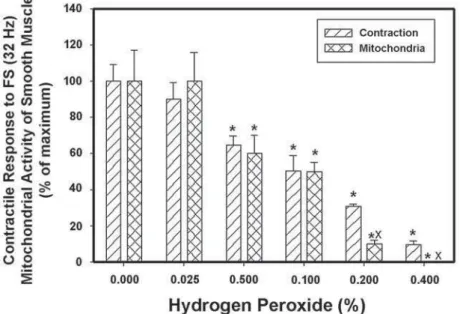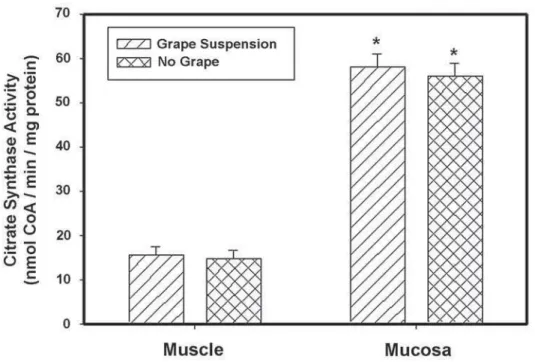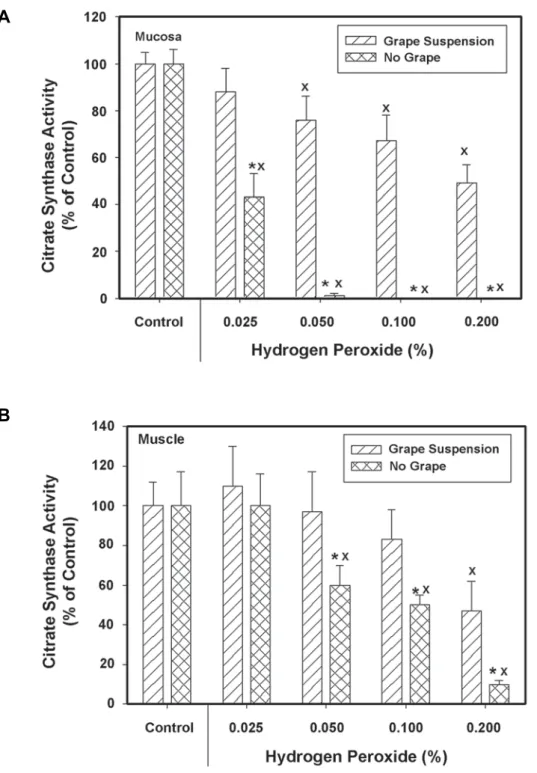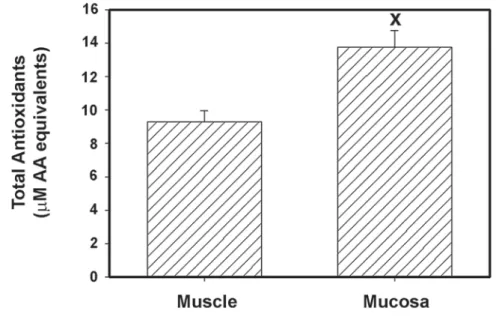Effect of Hydrogen Peroxide on Rabbit Urinary Bladder Citrate
Synthase Activity in the Presence and Absence of a Grape
Suspension
Vijay Venugopal, Robert E. Leggett, Catherine Schuler, Robert M. Levin
Albany College of Pharmacy and Health Sciences (VV, REL, CS, RML), Albany, New York, USA, Stratton VA Medical Center (RML), Albany, NY and Albany Medical College (CS, RML), Albany, New York, USA
ABSTRACT
Purpose: The etiology of obstructive bladder dysfunction includes free radical damage to mitochondria. Feeding rabbits a standardized grape suspension protects the ability of the bladder to contract and empty in part by preventing mitochondrial damage, thus maintaining smooth muscle and mucosal metabolism. The objective of the current study is to determine the direct effect of this grape suspension on the response of mitochondria to the oxidative effects of hydrogen peroxide. Materials and Methods: Six male rabbits were anesthetized with sodium pentobarbital and the bladders excised. Four full thickness strips were obtained for contractile studies and the balance separated into smooth muscle and mucosa compart-ments by blunt dissection. The effect of hydrogen peroxide on the contractile response to field stimulation was quantitated. Each tissue was homogenized and the effects of increasing concentrations of hydrogen peroxide in the presence and absence of grape suspension on citrate synthase activity was determined.
Results: Citrate synthase activity was significantly higher in the mucosa than in the muscle. The grape suspension had no effect on control citrate synthase activity. However, the grape suspension provided significant protection of both smooth muscle and mucosal citrate synthase activity.
Conclusions: These studies support the conclusion that the grape suspension provides direct protection of mitochondrial function.
Key words: urinary bladder; voiding dysfunction; antioxidants; oxidation
Int Braz J Urol. 2010; 36: 749-58
INTRODUCTION
Partial outlet obstruction secondary to BPH (benign prostatic hyperplasia) is a common affliction of aging men (1,2). Recent evidence has demonstrated that ischemia followed by reperfusion are major etiological factors in obstructive bladder dysfunc-tion (3,4). Specifically, blood flow to the bladder’s smooth muscle and mucosa decrease with obstructive
doi: 10.1590/S1677-55382010000600014
dysfunction resulting in tissue hypoxia, increased free radical generation, decreased contraction, denerva-tion, and mitochondrial dysfunction (5-7).
the formation of oxygen and hydrogen peroxide; the enzyme catalase is then responsible for reacting with the hydrogen peroxide (H2O2) species, to ultimately form water and oxygen. Partial outlet obstruction and in vivo models of ischemia have marked deleterious effects on superoxide dismutase and catalase, and as stated above have also been demonstrated to produce significant oxidative damage (10,12-14). A variety of antioxidants and natural products that show significant antioxidant properties have been shown to protect the rabbit urinary bladder from contractile, cellular, and subcellular damage and dysfunction mediated by both partial outlet obstruction, and bilateral ischemia / reperfusion (15-20). One of the most potent of these agents has been shown to be a grape suspension made from whole grapes (13,21,22). Grapes are known to have very significant antioxidant and membrane protective properties; characteristics which can ul-timately reduce the levels of generated free radicals and oxidative damage (23). In a series of published articles, we have clearly demonstrated that in-vivo oral administration of a standardized grape suspen-sion protected the bladder from both obstructive and ischemic damage (13,21,22). The antioxidants bind to free radicals, thus rendering them harmless.
From our studies on partial outlet obstruction and bilateral ischemia, we have shown that mito-chondria are one of the most sensitive sub-cellular organelles to develop oxidative stress and free radi-cal damage (3,4,24-27). We use citrate synthase as a marker enzyme for mitochondrial function (28,29). Citrate synthase is an enzyme found in virtually all living cells, and plays an important role in the first step of the Krebs, or Citric Acid Cycle (30-32). It is synthe-sized by the cytoplasm ribosomes and housed in the mitochondrial matrix (31,32). Its key role in the Krebs cycle is catalysis of the condensation reaction with acetyl coenzyme A (Acetyl-CoA) and oxaloacetate. This reaction involves the conversion of Acetyl-CoA, the thioester between coenzyme A (CoA) and acetic acid (AcOH), and oxaloacetate, the conjugate base of oxaloacetic acid, into citrate via an aldol condensa-tion reaccondensa-tion. The reaccondensa-tion produces CoA along with citrate, both of which are used extensively within the cycle (31,32).
We hypothesized that the mitochondrial citrate synthase activity of bladder tissue would
decrease proportionally when exposed to increasing concentrations of hydrogen peroxide, and that pre-treating the preparation with a grape suspension would reduce the level of damage caused by the peroxide.
MATERIALS AND METHODS
All studies were approved by the Institutional Animal Care and Use Committee of the Stratton VA Medical Center. Six male New Zealand rabbits were anesthetized with pentobarbital (25 mg/kg) and the bladder exposed through a midline incision. The bladder was sectioned between body and base at the level of the ureteral orifices. The bladder was opened longitudinally and 4 full thickness isolated strips were taken (1 x 0.3 mm) and mounted in individual baths containing oxygenated tyrodes solution (15 mL) at 37C for contractile studies. Two of the four strips from each bladder were incubated in the presence of 1 mg/mL grape suspension for 30 minutes; the other two strips were incubated in the presence of 1 mg/mL sugar composed of equal parts sucrose and fructose. The balance of the bladder was separated by blunt dissection into muscle and mucosal compartments and each compartment frozen in liquid nitrogen and stored at -80C for biochemical evaluation.
Grape Suspension (13,21,22)
A standardized freeze dried powder was kindly supplied by the California Table Grape Com-mission. The grape powder is a composite of whole red, green and blue-black California grapes, seeded and seedless varieties, in a freeze-dried powder form. It was created using Good Manufacturing Practices and precautions to preserve the integrity of the bio-logically active compounds found in fresh grapes. As with fresh grapes, the grape powder is known to contain anthocyanins, catechins, resveratrol, flavonols (including quercetin), flavans and simple phenolics as well as sugars. The composition has been published previously (21).
Contractile Studies (33)
Each isolated strip was allowed to equilibrate for 30 minutes. Passive tension (2g) was placed on each strip and equilibrated for an additional 30 minutes. Preliminary studies demonstrated that at 2g passive tension, maximal active tension is generated. Each strip was then stimulated by field stimulation (FS) at 32 Hz, 1 ms. 80V which gives a maximal contractile response. We start out with a stock solution of 25% H2O2. For the contractile studies, each isolated bath has 15 mL of Tyrode’s solution. We do an initial stimulation using field stimulation (32 Hz, 80V, 1 ms duration, 20 second train) monitoring the maximal contraction. The stock H2O2 solution was incubated for 30 minutes in a closed dark bottle at 37C. For the lowest H2O2 concentration, 0.025% we take out 15μL from the bath and add 15μL of 25% H2O2. Thus, the final concentration in the bath is 0.025% H2O2. We wait 10 minutes and then do a second stimulation. Similarly, we then take out an ad-ditional 15μL from the bath and place 15μL of the 25% H2O2 in order to get 0.05% H2O2 final concentration. We wait 10 minutes and then stimulate again. Similar operations give us the 0.1 and 0.2% H2O2. Dilution of the baths by these small volumes of H2O2 do not significantly change the chemical composition of the Tyrode’s solution. In this way, each bath receives a complete dose-response to H2O2.
Citrate Synthase Studies (28)
Samples of muscle and mucosa are homog-enized in 0.05M Tris buffer (200 mg/mL). Sample aliquots (100 μL) are added to ten 0.5 cm cuvettes, along with 1.0 mL 0.05M Tris buffer (pH 7.6), 100 μL 12.3 mM acetyl-coenzyme A, 100 μL 1 mM 5.5’- dithiobis-2-nitrobenzoic acid (DTNB), and 100 μL 10% Triton X-100. 10 mg/mL grape powder is added to cuvettes 1-5; 10 mg/mL sucrose-fructose is added to cuvettes 6-10 and the cuvettes incubated at 37C for 30 minutes. The final volume in each cuvette is 1400 mL excluding the 50 μL oxaloacetate (10 mM - substrate) used to start the reaction. The stock H2O2 solution is incubated at 37C for 30 minutes in a dark closed bottle before the experiment began. Before the oxaloacetate is added, 1.4 μL of the mixtures in
cuvettes 1 and 6 are removed and 1.4 μL of water added. Similarly, for cuvettes 2 and 7 1.4 μL of the mixtures are removed and 1.4 μL of 25% H2O2 are added (H2O2 final concentration - 0.025%). Similarly, cuvettes 3 and 8 are made to contain 0.05% H2O2; cuvettes 4 and 9 are made to contain 0.1%; and cu-vettes 5 and 10 contain 0.2% H2O2. After 10 minute incubations, the oxaloacetate is added and the free coenzyme-A generated by citrate synthase activity reacts with DTNB to form a colored compound that is quantified at 412 nm. Absorbance is recorded every 30 sec for 6 min (reaching steady state), using a Hitachi spectrophotometer.
CUPRAC Assay for Total Antioxidants (34,35)
The CUPRAC assay was utilized to determine the total antioxidant capacity of the homogenates of bladder smooth muscle and mucosa. This assay relies on the electron donating capabilities of antioxidants to reduce the copper ion. The CUPRAC working solution consisted of 10 mM copper (II) chloride dihydrate, 1 M ammonium acetate, and 7.5 mM neo-cuproine. 0.15 mL of the above three solutions were added to 0.15 mL of each sample and allowed to react for 30 minutes at room temperature, after which the absorbance was read at 450 nm in a Hitachi U-2001 spectrophotometer. The standard curve utilized in this assay was ascorbic acid with the following concentra-tions: 1000, 500, 250, 125, 62.5, 31.25 and 0µM.
BCA Protein Assay (Pierce) against a BSA protein standard
The final activity is given as activity per mg protein. This assay is performed on each of the tissues (muscle and mucosa) from each of the 6 individual rabbits.
Statistical Analyses
among individual groups; p < 0.05 required for sta-tistical significance.
RESULTS
Contraction and muscle citrate synthase activ-ity have similar sensitivities to H2O2 except at the two highest concentrations where there was a small but statistically significant difference (Figure-1).
The activity of the citrate synthase is sig-nificantly higher in the mucosa than the muscle. The grape suspension had no effect on the activity of con-trol muscle or mucosa (Figure-2). In order to visualize the comparison of the sensitivities of the muscle and mucosal preparations to H2O2, the citrate synthase activity in the absence of H2O2 has been normalized to 100% (Figure 3A and B). In the absence of the grape suspension, the citrate synthase activity of the mucosa was significantly more sensitive to H2O2 than was the muscle. For the mucosa, the citrate
synthase activity of the mucosa was protected at all concentrations of H2O2, (Figure-3A). For the muscle, the lowest concentration of H2O2 had no effect on citrate synthase activity in the presence or absence of the grape suspension; the citrate synthase activity of the muscle was protected by the grape suspension at 0.05; 0.1; and 0.2 % H2O2 (Figure-3B).
Figure-4 shows the total antioxidant activities of the muscle and mucosal homogenates. The mucosa has a significantly greater antioxidant activity than the muscle.
COMMENTS
These current studies confirmed that the citrate synthase activity of the mucosal tissue is significantly higher than the activity of the mucosa. Because the citrate synthase activity directly corre-sponds to the level of oxidative phosphorylation and ATP generation, one can conclude that the level of
* = significantly different from 0 H2O2. X = significantly different from contraction. Both the maximal contraction and citrate synthase activity were normalized to 100% for comparative purposes.
oxidative phosphorylation and rate of ATP generation is also significantly higher in the mucosal tissue than in the muscle; which supports previously published data (36,37).
The control bladder muscle and mucosa ci-trate synthase activity were not affected by the grape suspension. In the absence of the grape suspension, the mucosa was significantly more sensitive to the H2O2 than was the muscle; whereas the contractile response of isolated strips of bladder had a very similar sensitiv-ity to H2O2 as the smooth muscle homogenates. The grape suspension was very protective of the citrate synthase activity of both muscle and mucosa against damage by H2O2.
The citrate synthase activity in the presence of the grape suspension was significantly greater than the activity in the absence of the suspension at all concentrations. Interestingly, although the effect of peroxide in the absence of the grape suspension was significantly greater on the mucosal enzyme activity, the effect of peroxide in the presence of the grape
suspension was virtually identical for both muscle and mucosal tissues.
This difference in sensitivity to H2O2 in the absence of the grape suspension between muscle and mucosa led us to believe that there was a specific dif-ference between the supernatants of the mucosa and muscle. One obvious possibility is that the mucosa has a higher catalase activity than the muscle which would then make the hydrogen peroxide less effective in the muscle. However, prior studies on superoxide dismutase and catalase activities of the rabbit blad-der muscle and mucosa demonstrated that in fact the mucosa had a significantly higher catalase activity than the muscle (13,38).
Using the CUPRAC method of total anti-oxidant capacity, the mucosal homogenates have a significantly higher antioxidant activity than ho-mogenates of bladder smooth muscle which does not support the hypothesis that the smooth muscle preparations have a higher antioxidant activity than the mucosa.
* = significantly different muscle, p < 0.05.
* = significantly different from 0 H2O2.
X = significantly different from citrate synthase activity of muscle.
The citrate synthase activities of muscle and mucosa were normalized to 100% for comparative purposes
Figure 3 – Comparison of the effect of H2O2 on the citrate synthase activities of mucosa (A) and muscle (B). Each bar is the mean ± SEM of 6 individual rabbits.
A
We believe that it is the combination of anti-oxidants found in the grape suspension rather than an individual component that work in synergy to produce the protective effect. With other natural products, we have separated them into their individual components and found that none of the individual components worked as well as the parent product.
CONCLUSION
These data demonstrate that direct incuba-tion of a crude mitochondrial preparaincuba-tion of both rabbit bladder smooth muscle and mucosa with a standardized grape suspension significantly protects the integrity of citrate synthase activity. These results are entirely consistent with the in vivo studies on the protective effects of this same grape suspension on the functional damage mediated by partial outlet obstruc-tion and in vivo bilateral ischemia (13,21,22).
ACKNOWLEDGEMENTS
This material is based upon work supported in part by the Office of Research and Development
Medical Research Service, Department of Veteran’s Affairs, and in part by the Capital Region Medical Research Foundation.
The California Table Grape Commission supplied us with the freeze-dried whole grape powder used in these experiments.
CONFLICT OF INTEREST
None declared.
REFERENCES
1. Steers WD: Physiology of the urinary bladder, In Campbell’s Urology (ed.), Walsh PC, Retik B, Stamey TA, Vaughn ED, Saunders, Philadelphia. 1992; pp. 142-69.
2. Zderic SA, LRM, Wein AJ: Voiding Function and Dysfunction: A Relevant Anatomy, Physiology, and Pharmacology, and molecular biology. In: Adult and Pediatric Urology. JY Gillenwater JTG, Howards SS, Duckett JD (ed.), Mosby Year Book Medical Publish-ers, Chicago. 1996: pp. 1159-219.
3. Gosling JA, Kung LS, Dixon JS, Horan P, Whitbeck C, Levin RM: Correlation between the structure and
X = significantly greater than muscle, p < 0.05.
function of the rabbit urinary bladder following partial outlet obstruction. J Urol. 2000; 163: 1349-56. 4. Levin RM, Haugaard N, O’Connor L, Buttyan R, Das
A, Dixon JS, et al.: Obstructive response of human bladder to BPH vs. rabbit bladder response to partial outlet obstruction: a direct comparison. Neurourol Urodyn. 2000; 19: 609-29.
5. Schröder A, Chichester P, Kogan BA, Longhurst PA, Lieb J, Das AK, et al.: Effect of chronic bladder outlet obstruction on blood flow of the rabbit bladder. J Urol. 2001; 165: 640-6.
6. Greenland JE, Brading AF: The effect of bladder outflow obstruction on detrusor blood flow changes during the voiding cycle in conscious pigs. J Urol. 2001; 165: 245-8.
7. Greenland JE, Hvistendahl JJ, Andersen H, Jörgensen TM, McMurray G, Cortina-Borja M, et al.: The effect of bladder outlet obstruction on tissue oxygen tension and blood flow in the pig bladder. BJU Int. 2000; 85: 1109-14.
8. Aikawa K, Leggett RE, Levin RM: Effect of age on hydrogen peroxide mediated contraction damage in the male rat bladder. J Urol. 2003; 170: 2082-5. 9. Matsumoto S, Leggett RE, Levin RM: The effect of
vitamin E on the response of rabbit bladder smooth muscle to hydrogen peroxide. Mol Cell Biochem. 2003; 254: 347-51.
10. Kalorin CM, Mannikarottu A, Neumann P, Leggett R, Weisbrot J, Johnson A, et al.: Protein oxidation as a novel biomarker of bladder decompensation. BJU Int. 2008; 102: 495-9.
11. Siflinger-Birnboim A, Levin RM, Hass MA: Partial outlet obstruction of the rabbit urinary bladder induces selective protein oxidation. Neurourol Urodyn. 2008; 27: 532-9.
12. Juan YS, Lin WY, Kalorin C, Kogan BA, Levin RM, Mannikarottu A: The effect of partial bladder outlet obstruction on carbonyl and nitrotyrosine distribution in rabbit bladder. Urology. 2007; 70: 1249-53. 13. Lin AD, Mannikarottu A, Kogan BA, Whitbeck C,
Leggett RE, Levin RM: Effect of bilateral in vivo ischemia/reperfusion on the activities of superoxide dismutase and catalase: response to a standardized grape suspension. Mol Cell Biochem. 2007; 296: 11-6.
14. Erdem E, Leggett R, Dicks B, Kogan BA, Levin RM: Effect of bladder ischaemia/reperfusion on superoxide dismutase activity and contraction. BJU Int. 2005; 96: 169-74.
15. Levin RM, Riffaud JP, Bellamy F, Rohrmann D, Habib M, Krasnopolsky L, et al.: Protective effect of Tadenan
on bladder function secondary to partial outlet obstruc-tion. J Urol. 1996; 155: 1466-70.
16. Levin RM, Riffaud JP, Bellamy F, Rohrmann D, Krasnopolsky L, Haugaard N, et al.: Effects of tadenan pretreatment on bladder physiology and biochemistry following partial outlet obstruction. J Urol. 1996; 156: 2084-8.
17. Levin RM, Kawashima Y, Leggett RE, Whitbeck C, Horan P, Mizutani K: Effect of oral Kohki tea on bladder dysfunction induced by severe partial outlet obstruction. J Urol. 2002; 167: 2260-6.
18. Levin RM, Leggett RE, Whitbeck C, Matsumoto S, Ohto N, Ikeda T, et al.: Kohki tea protects the rabbit bladder from ischemia/reperfusion-induced contractile dysfunction. Urol Int. 2008; 80: 425-30.
19. Juan YS, Hydery T, Mannikarottu A, Kogan B, Schuler C, Leggett RE, et al.: Coenzyme Q10 protect against ischemia/reperfusion induced biochemical and func-tional changes in rabbit urinary bladder. Mol Cell Biochem. 2008; 311: 73-80.
20. Juan YS, Levin RM, Chuang SM, Hydery T, Li S, Kogan B, et al.: The beneficial effect of coenzyme Q10 and lipoic acid on obstructive bladder dysfunction in the rabbit. J Urol. 2008; 180: 2234-40.
21. Agartan CA, Whitbeck C, Sokol R, Chichester P, Levin RM: Protection of urinary bladder function by grape suspension. Phytother Res. 2004; 18: 1013-8. 22. Lin AD, Mannikarottu A, Chaudhry A, Whitbeck C,
Kogan BA, Chichester P, et al.: Protective effects of grape suspension on in vivo ischaemia/reperfusion of the rabbit bladder. BJU Int. 2005; 96: 1397-402. 23. Dohadwala MM, Vita JA: Grapes and cardiovascular
disease, J Nutr. 2009; 139: 1788S-93S.
24. Levin RM, Hudson AP: The molecular genetic basis of mitochondrial malfunction in bladder tissue following outlet obstruction. J Urol. 2004; 172: 438-47.
25. Levin RM, Monson FC, Haugaard N, Buttyan R, Hudson A, Roelofs M, et al.: Genetic and cellular characteristics of bladder outlet obstruction. Urol Clin North Am. 1995; 22: 263-83.
26. Nevel-McGarvey CA, Levin RM, Haugaard N, Wu X, Hudson AP: Mitochondrial involvement in bladder function and dysfunction. Mol Cell Biochem. 1999; 194: 1-15.
27. Wang Z, Wu X, Levin RM, Hudson AP: Loss of mitochondrial DNA in rabbit bladder smooth muscle following partial outlet obstruction results from lack of organellar DNA replication. Mol Urol. 2001; 5: 99-104.
malate dehydrogenase and citrate synthase activity. J Urol. 1992; 147: 1391-3. Erratum in: J Urol. 1992; 148: 1922.
29. Makeeva AV, Popova TN, Matasova LV, Yama IN: Effects of lipoic acid on citrate content, aconitate hydratase activity, and oxidative status during myo-cardial ischemia in rats. Biochemistry (Mosc). 2008; 73: 76-9.
30. O’Toole JF, Patel HV, Naples CJ, Fujioka H, Hoppel CL: Decreased cytochrome c mediates an age-related decline of oxidative phosphorylation in rat kidney mitochondria. Biochem J. 2010; 427: 105-12. 31. Remington SJ: Structure and mechanism of citrate
synthase. Curr Top Cell Regul. 1992; 33: 209-29. 32. Wiegand G, Remington SJ: Citrate synthase: structure,
control, and mechanism. Annu Rev Biophys Biophys Chem. 1986; 15: 97-117.
33. Levin RM, Brading AF, Mills IW, Longhust PA: Experimental Models of Bladder Obstruction, In: Prostatic Diseases (ed.), Lepor H. W.B. Saunders Co., Philadelphia. 2000; pp. 169-96.
34. Bean H, Radu F, De E, Schuler C, Leggett RE, Levin RM: Comparative evaluation of antioxidant reactivity within obstructed and control rabbit urinary bladder tissue using FRAP and CUPRAC assays. Mol Cell Biochem. 2009; 323: 139-42.
35. Radu F, Schuler C, Leggett RE, Levin RM: Com-parative evaluation of antioxidant reactivity between ovariectomized and control urinary bladder tissue using FRAP and CUPRAC assays, LUTS. 2009; 1: 93-7.
36. Hypolite JA, Longhurst PA, Gong C, Briscoe J, Wein AJ, Levin RM: Metabolic studies on rabbit bladder smooth muscle and mucosa. Mol Cell Biochem. 1993; 125: 35-42.
37. Levin RM, High J, Wein AJ: Metabolic and contractile effects of anoxia on the rabbit urinary bladder. J Urol. 1982; 128: 194-6.
38. Onal B, Levin RM, Kogan BA, Guven A, Leggett RE, Mannikarottu AS: Novel alterations in superoxide dismutase and catalase activities in the female rabbit bladder subjected to hormonal manipulations. Int Urol Nephrol. 2007; 39: 1049-54.
Accepted after revision: May 26, 2010
Correspondence address: Dr. Robert M. Levin
Albany College of Pharmacy & Health Sciences 106 New Scotland Ave
Albany, NY, 12208, USA Fax: + 1 518 694-7248
E-mail: robert.levin@acphs.edu
EDITORIAL COMMENT
Protective effects of grape extracts have been widely developed and already in 2003, Helen Kolettis published a paper entitled “The Goodness of Grapes”.
Active components of grape extracts include polyphenols, anthocyanins, flavonoids which are present in grape seed, grape skin and grape juice.
Interest in natural phytotherapic produces increases from many years due to their expected ef-ficacy, to organoleptic factors and to the great com-pliance of consumers for that treatment because most of them believe that herbal medicines are safe because they are natural. The number of scientific articles dealing with herbal medicine has increased from almost zero in 1990 to over 15,000 in 2007.
Originality of this study is to give insights on the direct protection of mitochondrial function
after treatment with a grape suspension, because this study is a complement to a previous paper on the in vivo effects of grape suspension on bladder function of rabbit.
Studies of the effect of each component of the grape extract could be more informative al-though the authors think that a combination of an-tioxidants works in synergy. That question has been already widely evoked for studies of the effects of on bladder function following intake of Pygeum africa-num extracts (Tadenan), Serona repens (Permixon) or Saw Palmetto.
Dr. Françoise A. Valentini



